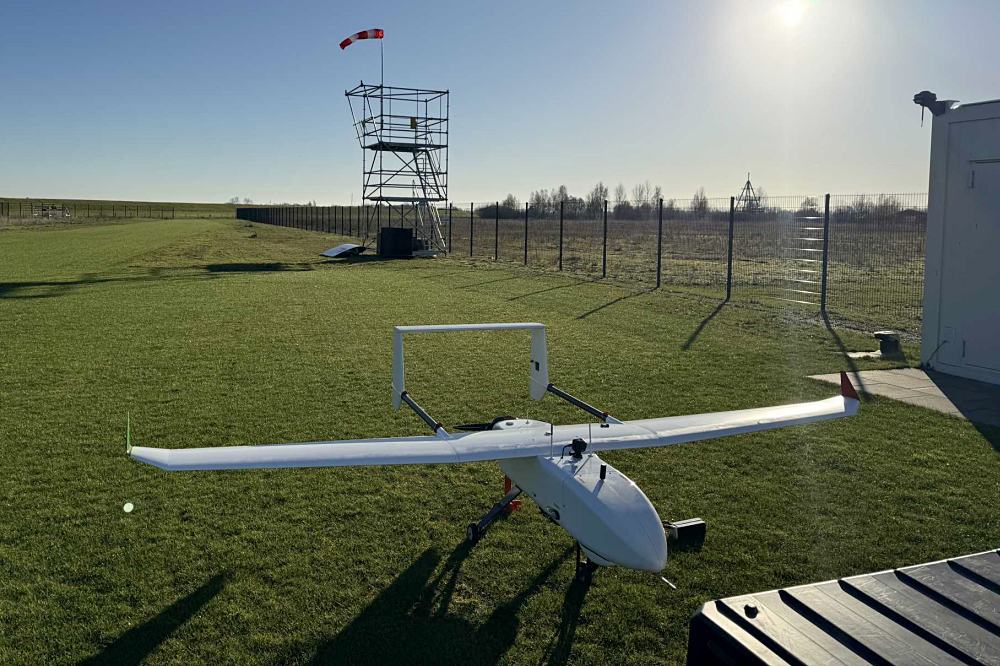As part of a project collaboration, Fraunhofer IFAM and Droniq GmbH successfully carried out a 180-kilometer drone flight from the Offshore Drone Campus Cuxhaven (ODCC) to Helgoland and back. For the first time, the safe integration of unmanned BVLOS flights over the sea was achieved in compliance with civil regulations and with the involvement of all relevant stakeholders.
At the same time, the flight marked the first long-distance drone operation seamlessly coordinated with manned air traffic.
The drone flight was conducted as part of an initial test mission to explore long-distance flights over the sea. The operation was carried out beyond the pilot’s visual line of sight (BVLOS). The aim of these missions is to establish such distance flights using drones over the North and Baltic Seas for civil applications, in harmony with manned aviation and ongoing maritime traffic. Potential use cases include protecting critical infrastructure, monitoring shipping lanes, environmental monitoring, or supporting maritime emergency management.
“With drones, we have a tool that can help implement a wide range of applications and in a significantly more resource-efficient way than before,” explains Tim Strohbach, Group Leader for “Maritime Drone Applications” at Fraunhofer IFAM. “Manned and unmanned air traffic must always operate together safely,” adds Droniq CEO Jan-Eric Putze. “We have now demonstrated that this is also possible with long-distance drone flights. This marks a milestone for the further development of unmanned aviation.”
The flight originated from the recently inaugurated Offshore Drone Campus Cuxhaven (ODCC), operated by Fraunhofer IFAM. The drone used for the mission was provided by Bremen-based Hanseatic Aviation Solutions: the HAS S360 Mk.II, a fixed-wing aircraft with a wingspan of 3.6 meters, a payload capacity of 5 kilograms, and a takeoff weight of approximately 25 kilograms. The drone, equipped with a combustion engine, can fly at speeds of up to 100 km/h.

The long-distance flight was conducted using the HAS S360 Mk.II drone from Bremen-based Hanseatic Aviation Solutions – Copyright Droniq GmbH
During the test mission, the drone initially flew from Cuxhaven into the Elbe estuary. From there, it followed the shipping lane to Helgoland and back—a total flight distance of 180 kilometers. The ground station at the ODCC coordinated the entire flight. The drone flew at an altitude of just over 200 meters. To ensure safe operation, it was equipped with various safety features, including a parachute, satellite communication, aeronautical radio, a transponder, and a flotation device in case of an emergency water landing.
Droniq’s ground-based sensor technology also provided the drone pilot with real-time updates on air traffic. During the flight, communication links, aeronautical radio, and other systems were tested.

During the test mission, the drone flew from Cuxhaven into the Elbe estuary, following the shipping lane to Helgoland and back – a total distance of 180 kilometers – Copyright Fraunhofer IFAM
Droniq and Fraunhofer IFAM jointly developed the operational concept for the flight and coordinated all approval processes with manned aviation and maritime stakeholders. The flight route was also defined collaboratively with all relevant parties.
Next year, Fraunhofer IFAM and Droniq plan to conduct additional test flights to further explore the regular integration of drones into airspace operations.
Top Photo: To ensure a safe flight, the drone was equipped with a parachute, satellite communication, aeronautical radio, a transponder, and a flotation device in case of an emergency water landing – Copyright Fraunhofer IFAM
Source: Droniq

